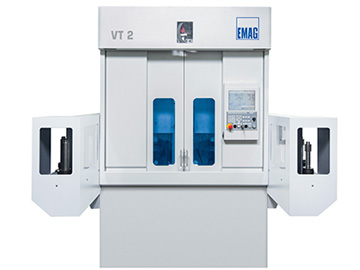VT 2 Vertical Turning Machine: A Shift in Performance in the Production of Electric Motors
According to market experts, the demand for electric motors will grow dramatically, and new transmission systems will continue to become more efficient. The European Union commission, for example, has expressed that inefficient motors presently used in the automotive industry and other sectors should be replaced with new electric motors by 2020. To ensure that the manufacture of complex components becomes even more efficient, the focus must be on the systems used to make them. The EMAG Group has developed a customized solution for the manufacture of shafts for electric motors: their fully automated VT 2 Vertical Turning Machine.

According to the latest EU guidelines on the manufacture of electric motors, the energy-efficiency of many electric transmission systems is to be increased by 30 percent. As manufacturers explore this market opportunity, this development also brings with it some challenges. As the manufacture of these components not only calls for more effective solutions, the design of these modern motors also increases the demands made on its constituent components. “We are aware of these challenges in the manufacture of the central components for electric motors,” explains Dr. Guido Hegener, Managing Director of EMAG Salach Maschinenfabrik GmbH. “A particular focal point is the demanding manufacturing process for shaft components, where a lot depends on the machine tool used. In a batch production environment idle times must be kept short and component costs low. But this must be achieved without a loss of flexibility in the production process.”
Automation Ensures Short Idle Times
The specialists at EMAG have developed a solution for the machining of shafts up to 400 mm (15.7 in.) in length and 63 mm (2.5 in.) in diameter with their VT 2 4-axes Vertical Pick-Up Turning Machine. Its automation provides for very fast chip-to- chip times and ensures component costs are kept low. Workpiece pick-up’s are used to transport the raw-parts into the machine and retrieve them again upon completion of the machining process. Depending on the component, the changeover time can be as short as six seconds. “In a mass production environment such short idle times quickly add up to provide enormous time savings,” adds Hegener. “They also guarantee an energy-efficient production process, as a large part of a machine tool’s energy is consumed during downtimes.”
The actual turning process, with spindle speeds of up to 6,000 rpm, also helps to achieve extremely short cycle times. The shaft is clamped vertically between the work spindle and the tailstock and machined from two sides. This work is done by two turrets with twelve tool stations each. The stations can be equipped with turning tools and driven tools (with one station being occupied by the pick-up device). For milling work, required for keyways for example, the machine can be equipped with a Y-axis. The vertical alignment of the workpiece ensures permanent process integrity, where the unhindered chip flow prevents the build-up of chips in the machining area.
A True Space-Saver
Another decisive factor for economic production is the external dimension of the machine tool. In the VT 2, the machine base is already small as the vertical design minimizes its footprint. Production planners also don’t have to provide for additional raw-part and finished component storage, as this is integrated into the VT 2. These machines can also be linked-up in close formation, forming a complete manufacturing line. “We have developed altogether a very compact manufacturing system that is very flexible and a safe investment for the future,” explains Hegener.
“There are a lot of possible applications out there for this system, especially in the manufacture of shafts for electric motors,” says Hegener. “We are offering a machine tool that allows the user to implement demanding machining processes and to save massively on costs. This kind of quality will no doubt assert itself.”
About EMAG
The success of EMAG’s strategy lies in the fact that a medium-sized corporation can still react to customer requirements with flexibility and attention to the long term prospect. After all, clients are looking for answers to the crucial question of how to improve their output and the quality of their production – and to do so with space-saving machinery that will not let them down, even after many years of use. EMAG is the world’s most important manufacturer of CNC vertical turning machines.
For more information, visit www.emag.com.



















